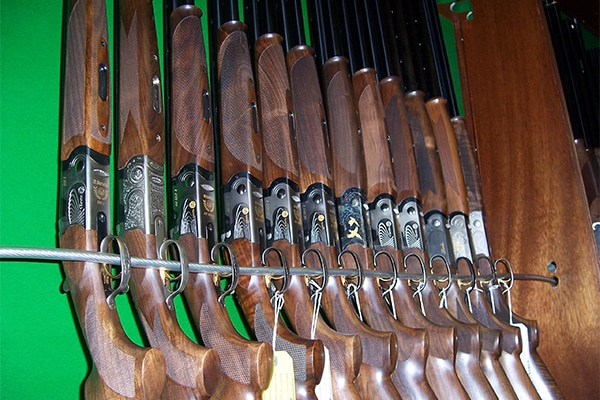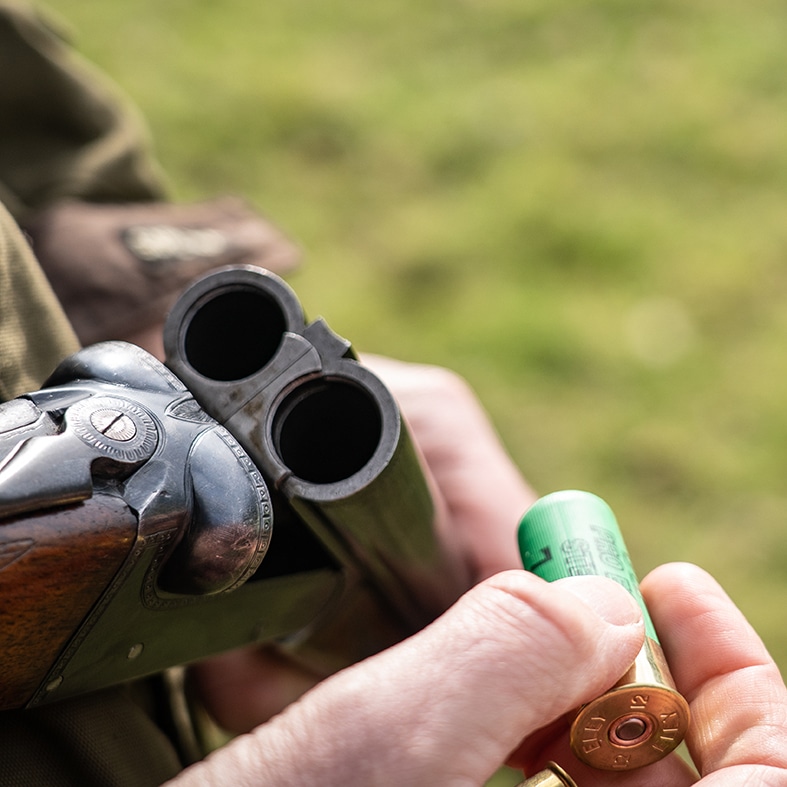
Firearms security
A comprehensive guide to firearms security, including advice on travelling with guns and firearms in rented accommodation.
Get information on the legal shooting season for mammals and birds in the UK.
Apply for funding for your project or make a donation today
Comprehensive information and advice from our specialist firearms team.
Everything you need to know about shotgun, rifle and airgun ammunition.
Find our up-to-date information, advice and links to government resources.
Everything you need to know on firearms law and licensing.
All the latest news and advice on general licences and how they affect you.


This is a code of practice for those who load for others. If followed, it will contribute to a safe and responsible future for the sport. It is primarily aimed at those who have successfully completed a loading qualification, such as that provided by Lantra Awards. The code will support and supplement the novice’s training and attainment of a qualification. This code should be read in conjunction with the BASC Shotgun Safety Code of Practice.
High standards underpin public and political support for shooting, now and in the future.
The code provides advice at two levels:
The following golden rules apply:

Want to check your Loading for other people knowledge, take our free online test.
As a loader you will often work with shooting clients who have different requirements and varying levels of competence. The relationship is often directly between the loader and the shooting client, so make sure that your responsibilities are agreed before you start shooting. Remember, safety and security is ultimately the shotgun certificate holder’s responsibility.
There are three main roles that a loader may be asked to perform; these are:
There will be situations where a mix of some of these roles will be requested or required. The most important aspects of the loader/shooting client interaction will be the level of instruction given, the amount of feedback and coaching provided, and the level of small talk expected. Some shooting clients will require full interaction from the loader, while more experienced Guns may only require clear instructions regarding the reloading operation.
Typically, the more experienced shots will only expect you to provide coaching or advice when asked.
Coaching is not compatible with double gunning. When double gunning the loader is performing a technically demanding role with little or no opportunity to observe and coach to any proficient level.
Above all, safety is the most important consideration. Always be aware of the direction in which the muzzle of your shooting client’s shotgun is pointing and never allow the gun(s) to point in an unsafe direction.
Whenever you are loading, you should be aware of the safe arcs of fire and advise your shooting client where their shot may fall before each drive.
Also advise your shooting client where the beaters and pickers up are likely to be positioned throughout the drive.
BASC promotes and insists on safe and sensible behaviour by shooters in all disciplines. You should act on these points to reassure shooters and non-shooters alike, that you and your shooting client can be trusted to be safe with a shotgun:
Below, is a summary of the main quarry species likely to be encountered on a driven shoot. This is not an exhaustive list, and it is recommended that the BASC Pocket Guide to Quarry Identification is consulted.
As part of the loader’s personal development it is recommended that other relevant wildlife identification resources are also consulted.
In formal driven shooting you will normally be dealing with over-and-under or side-by-side shotguns. These will be primarily 12, 20 and 28 bore, but other bores such as 16 and .410 might occasionally be encountered.
The gun(s) will either be a single gun or a pair of guns. Pairs come in two forms: matched and composed.
A composed pair is generally two unrelated guns of the same type or specification, put together by a maker.
Matched pairs are two guns made consecutively, with the same stock blanks and the same craftsmen producing each part of the gun to the same specification and standard.
Some shotguns will have assisted opening or self-opening mechanisms.
For efficient and safe loading the guns should be breech loading, ejecting, with automatic safety catches. They must be of sound condition and in proof.
The guns will vary in chamber length from 2 to 3½ inch, which is important when determining which cartridges to use.
The safety catch should normally be automatic, but check that it is not manual.
In double gunning, the loader should hand the gun to the shooting client with the safety catch on. A gun should not be passed with the safety catch off as this is unsafe.
It is good practice for the loader to make checks on the gun(s) being used by the shooting client. This may be an agreed requirement of the loader/shooting client relationship.
A quick visual check will reveal any cracks in the stock or fore-end, dents or bulges in the barrels and lifting or sprung ribs.
Multi-chokes should be present and tight. Make sure the barrels are not ‘off the face’ (or loose).
If there is any chance that the damaged gun could cause harm to either the loader, shooting client or other members of the shooting party, the shooting client must be informed of the damage and it must not be used.
The loader must be familiar with proof information and where to find this information on the gun. This is particularly important in relation to which cartridges may be safely used in which gun.
Many guns are not proofed for high performance cartridges or for steel shot. You must also check that the stated chamber length of the gun exceeds that of the cartridge length.
Ensure that the cartridge type and shot size is suitable for both the quarry and the gun. If you use non-lead shot, make sure the gun and cartridge are compatible, otherwise damage could occur.
It is very important not to allow cartridges of different bores to become mixed. A smaller size (say a 20 bore) can be inadvertently loaded into a 12 bore gun and lodge in the barrel.
If a 12 bore cartridge is then loaded and fired over the top, it can burst the barrel and cause fatal injuries. You must have no cartridges in your pocket except those of the gauge you are about to load.
There are two common cartridge malfunctions, hang fires and misfires, both of which can be caused by errors in cartridge manufacture or a faulty shotgun. Repeated misfires and hang fires could be a sign of worn firing pins, and the gun should be repaired by a reputable gunsmith.
This is when the cartridge fails to fire upon pulling the trigger, but does fire after a delay. What usually happens is that the cartridge fails to fire altogether, even though the primer of the cartridge has been struck.
The gun should be pointed in a safe direction and held securely for 30 seconds. Looking away from the action, the gun should be opened slowly and the cartridge removed.
If the cartridge makes an unusual or muffled noise upon firing, or the recoil is reduced, it should be presumed that a misfire may have occurred.
The gun needs to be lowered in a safe direction and opened slowly; the barrels should then be inspected for blockages or damage.
This is a method often used by shotgun coaches while instructing ‘on the peg’. As a technique, it offers the coach more control over the shooting process.
From a loader’s perspective
A shooting client’s perspective
It is important that the shooting client’s experience is matched with that of the loader’s experience. For instance, it would be unwise to pair an inexperienced shooting client with an inexperienced loader.
A loader’s perspective
A shooting client’s perspective
On many shoots it is customary for the loader to clean the shooting client’s shotgun(s) once the day’s shooting has finished. The loader should always bring a complete cleaning kit with them just in case.
Cleaning kit
A basic loader’s cleaning kit should consist of the following:
If the guns have been used in wet conditions, it is very important to dry them thoroughly with towels first.
Every loader or assistant will have their own cleaning routine or will develop one with experience.
The loader must bear in mind that they may be judged on the thoroughness of their work by the shooting client, so it is important to have good cleaning procedures in place.
Remember to scrub the inside of the barrels thoroughly to remove the build-up of plastic and other residues.
Clean the rest of the gun and grease-bearing surfaces. Excess oil should be removed to prevent it soaking into the wooden surfaces, which may weaken the gun over time.
There will not always be the time to do a thorough cleaning job, particularly if the client needs to get away quickly.
In these situations there may be only an opportunity to dry the gun and run it through with the cleaning rods.
Guns can be stored in slips overnight, only if the slips are dry. For this reason the loader should have spare slips to use for overnight storage.
Many larger shoots or sporting accommodation will have dedicated gunrooms or cabinets where the guns can be stored overnight. Shotguns should not be stored in vehicles overnight.
If no secure storage is available, it is best that the barrels are stored separately in a locked vehicle and stocks and forends are kept in your luggage in the hotel or house.
Ideally guns should be dismantled and stored in a dry case for transit, and packed in such a way that they cannot move around.
The loader should check his equipment list, dry all equipment which has become damp and check all zips and buckles for breakages. Any of the loader’s equipment which is damaged or missing should be replaced.
It is essential for you and your shooting client to have adequate legal liability (third party) insurance when shooting. BASC has a Professional Insurance package which covers loading and double gunning. Find out more.
The BASC ideal is that all who shoot conduct themselves according to the law and to the highest standards of safety, sportsmanship and courtesy, with full respect for their quarry and a practical interest in wildlife conservation and the countryside.
Never guess at what the law allows. If in doubt, contact BASC.

A comprehensive guide to firearms security, including advice on travelling with guns and firearms in rented accommodation.

Information on the definition of a crossbow, legislation around sale and hire of crossbows plus possession by those under the age of 18.

From 24 September 2024, zombie-style knives and machetes will be added to the list of prohibited weapons under The Criminal Justice Act 1988 (Offensive Weapons) Order.